Terri Albanese Mosaic Art an International Portfolio of Contemporary Mosaic Art

Long-Term Regional Ecology Risk Cess and Time to come Scenario Projection at Ningbo, China Coupling the Impact of Sea Level Rise
1
Higher of Surveying and Geo-Informatics, Tongji University, Shanghai 200092, China
ii
School of Globe and Environmental Sciences, The University of Queensland, Brisbane, QLD 4072, Commonwealth of australia
3
College of Marine Sciences, Shanghai Ocean Academy, Shanghai 201306, People's republic of china
*
Authors to whom correspondence should be addressed.
Received: 18 Feb 2019 / Revised: 5 March 2019 / Accepted: 8 March 2019 / Published: 14 March 2019
Abstract
Regional ecology run a risk (RER) denotes potential threats to the natural environment, man health and socioeconomic development caused past specific risks. Information technology is valuable to assess long-term RER in coastal areas with the increasing effects of global change. Nosotros proposed a new arroyo to assess coastal RER considering spatial factors using principal component analysis (PCA) and used a futurity country employ simulation (FLUS) model to project hereafter RER scenarios considering the bear upon of body of water level rise (SLR). In our study, the RER status was classified in five levels as highest, loftier, medium, low and lowest. Nosotros evaluated the 30 m × 30 chiliad gridded spatial pattern of the long-term RER at Ningbo of China by assessing its 1975–2015 history and projecting this to 2020–2050. Our results show that RER at Ningbo has increased substantially over the past 40 years and volition slowly increment over the next 35 years. Ningbo's city centre and district centers are exposed to medium-to-highest RER, while the suburban areas are exposed to lowest-to-medium lower RER. Storm surges will pb to stiff RER increases along the Ningbo coast, with the low-lying northern declension being more than afflicted than the mountainous southern declension. RER at Ningbo is afflicted principally by the combined effects of increased human activity, rapid population growth, rapid industrialization, and unprecedented urbanization. This study provides early warnings to support practical regulation for disaster mitigation and environmental protection.
1. Introduction
Regional environmental risk (RER) denotes potential threats to the natural environment, human health and socioeconomic development caused past specific risks [ane,ii]. RER tin can be expressed past incertitude in the effect and degree of environmental damage [2]. For example, industrial and domestic wastes create potential environmental risks that may threaten the sustainability of urban systems [3,four]. Land-use alter, accompanied by accelerating industrialization and urbanization, has led to the alteration of the natural environment and ecosystem deposition [v,6]. Intensified human being impacts have led to accumulated greenhouse effects and global change, ultimately resulting in global warming and sea level ascent (SLR) [seven]. SLR increases the intensity and frequency of storm surges, intensifying RER in littoral areas that are significantly affected by inundation [8]. Coastal regions will be exposed to increased RER because the ecosystems and environments are inherently vulnerable. It is therefore essential to consider the touch on of SLR in long-term RER assessment and future scenario projection in coastal areas.
RER assessment is to synthetically evaluate the risk sources, risk receptors and risk retardation from a macro perspective [nine,10], offering possible countermeasures that can reduce risks. Efforts have been fabricated to the spatial and quantitative assessment of RER as it relates to specific combinations of risks. Aiming to develop risk-mitigation measures, modelers accept assessed RER in inland and littoral zones regarding hazardous substances [11] and pollutants [9,12]. From a spatial perspective, a few publications have evaluated RER acquired by multiple run a risk sources [13], metal in soil [14], vulnerable ecology factors [15] and toxic compounds [sixteen]. These studies have mapped RER patterns to identify high-risk areas and back up the conception of sustainable evolution plans. In RER studies, a Pressure-State-Response (PSR) framework has commonly been applied to estimate the gamble level [x,17], with the support of the analytical bureaucracy procedure (AHP) and geographical information systems (GIS). The entropy method [xviii], fuzzy method [19] and expert evaluation method (EEM) [20] accept also been applied to the assessment of ecological security related to RER. While AHP and EEM have been applied to evaluate RER patterns with the absence of prior noesis of risk levels [17,21], they strongly depend on subjective model parameterization that can influence the credibility of the results. In coastal areas, the impacts of body of water level rise on environments have commonly been studied using 3 basic approaches, i.due east., behavior-oriented models [22], process-based models [23] and hybrid models [24]. McLeod et al. [25] summarized these coastal touch on models and noted a few of them including inundation models (east.1000., GIS), SLAMM, BTELSS, DIVA, and SimCLIM. These models tin can predict a wide range of coastal environments such as morphological development and estuarine sedimentation.
Despite considerable progress in the study of RER, improved assessment methods must consider other physical and socioeconomic driving forces, specially because coastal environments are now substantially afflicted past global change and SLR. As a result, disquisitional issues related to RER include: (1) objective parameterization for assessing spatial patterns of RER, (two) proper projection of future RER scenarios, and (3) comprehensive cess of future RER patterns considering the influences of SLR and storm surges. In this written report, storm surge refers to littoral flooding commonly associated with typhoons, heavy rainfall and farthermost high tides [26], which may increase social vulnerability and environmental risks. To date, answers to these questions have non been adequately addressed, and further studies are needed for model development and integrated environmental management.
The objective of this study is to adequately address the above bug by developing new methods for assessing RER patterns and projecting their time to come scenarios. Our new assessment method is based on the master component analysis (PCA). It is a dimensionality reduction method whose outputs are directly derived from the independent factors [27], leading to the objective definition of the effects of these factors. State coverage indices and distance-based factors were applied as input variables for the modeling. These variables are representative of the land coverage status, man impacts, and socioeconomic aspect. Our new method too incorporates GIS to facilitate the spatial visualization [sixteen,17,28,29,thirty] and the quantification [31,32,33] of RER condition, providing a clearer understanding. We used a bottom-upwardly cellular automata (CA) model to project futurity scenarios by processing the RER maps into categorical figures. CA models have been widely applied to simulate and predict spatiotemporal, dynamic phenomena [34,35]. The models can automatically update their transition rules during the simulation procedure, and have substantial advantages of chiselled modeling in tessellated infinite but weak capabilities to model continuous value-based spatial phenomena [36]. We applied the futurity land use simulation (FLUS) model, a state-of-fine art CA tool for modeling complex land use change and spatiotemporal phenomena [35,37], to predict the RER time to come scenarios.
ii. Methodology
two.1. Procedure
For modeling RER (Figure 1), we beginning used remote sensing imagery and vector maps to derive the factors impacting RER at Ningbo. Based on these factors, nosotros then practical PCA to evaluate the nowadays RER pattern in 2015 and to assess the past RER patterns for 1975, 1990 and 2006. Consequently, the FLUS model of spatial phenomena [35,37] was used to project earlier-inundation RER scenarios from 2020 to 2050. We and then applied a GIS approach (flood model) to evaluate after-overflowing RER scenarios from 2020 to 2050, taking into business relationship terrain (from a digital peak model: DEM), SLR and storm surge. Our long-term RER assessment should assist codify more than appropriate plans for regional development and environmental protection, and could aid constitute defensive measures to rehabilitate coastal environments by taking SLR into business relationship.
2.two. Study Surface area and Input Data
Ningbo is a port metropolis situated in the middle of Communist china's east coast (Figure 2a). The city covers 9816 km2 and consists of ii county-level cities (Cixi and Yuyao), ii counties (Ninghai and Xiangshan), and half dozen districts (Jinzhou, Haishu, Jiangbei, Zhenhai, Beilun and Fenghua) (Effigy 2b). Haishu and Jinzhou institute the Ningbo City center. Ningbo is an economic middle of the southern wing of the Yangtze River Delta [38], and is the eastern departure port for the 'Marine Silk Route' on the Yongjiang River estuary.
Equally of 2015, Ningbo'south population was ~vii.eight meg [39], and the almanac GDP was ~801 billion Chinese Yuan (~121 billion USD) [39]. A vast population and a vibrant economy have resulted in high demand for commercial and residential space, leading to unprecedented land-use changes that pose serious challenges to ecosystems and the natural environs. Due to the major changes in land-use and environmental pressure, Ningbo has attracted attention from environmentalists and local authorities [40,41] and is of great interest to environmentalists, geographers and scientists [42,43].
Nosotros used graphic GIS datasets and remote sensing imagery (Table 1) to derive spatial factors influencing RER at Ningbo. The Ningbo City center and district/county centers were defined using administrative maps, which differ between 1975–1990 and 2006–2015. Four Landsat images were used to compute the normalized difference vegetation alphabetize (NDVI) and the normalized difference building index (NDBI). The terrain at Ningbo was stable over the past iv decades, thus nosotros used only the 2010 DEM to guide the impact of terrain on time to come RER scenarios.
2.3. Input Variables
Increasing human need for natural and land resources has put great pressure level on the natural environment [44] from facility construction, landscape amending, urban development and land reclamation [45,46]. This has led to global land-use change, reduction in vegetation coverage, and growth in congenital-upwardly areas [47]. We selected four typical spatial influencing factors to evaluate RER patterns at Ningbo: proximity to Ningbo urban center center (PNCC), proximity to commune centers (PDC), NDVI and NDBI, every bit defined in Table 2. Using the ArcGIS Euclidean Distance tool, we calculated PNCC and PDC to represent the distance from each pixel and its nearest urban center/district centers; using the ArcGIS Map Algebra tool, we computed NDVI and NDBI to describe the state coverage status.
Ningbo City center and the district centers have the highest density of impervious surfaces, suggesting the major human alteration of the natural environments. The use of proximity factors is therefore effective in delineating RER caused by human disturbance. Generally, a higher PNCC (or PDC) suggests a lower building density and higher vegetation coverage, hence a weaker human impact and less-altered natural environments [20,21]. Nosotros produced i PNCC map and ii PDC maps using the administrative maps in 1990 and 2006 (Figure 3a–c). These two factors are temporally stationary when including them to appraise the past RER scenarios as well as projecting the before-inundation scenarios. The topo-bathymetry was considered for the after-flood scenarios.
NDVI reflects vegetation coverage and is an important indicator of the integrity of ecological environments, with a college NDVI indicating a less-altered natural environment [48]. Effigy 3d–g shows a decline in vegetation coverage at Ningbo from 1975 to 2015. The congenital-up density reflects the intensity of man-disturbance and probably population density [49], and a higher built-up density suggests a greater human alteration of the natural environments [50]. Figure 3h–k shows the NDBI maps that measure the built-up density as an important indicator of man impacts, reflecting the condition of man-fabricated surfaces. The maps in Effigy 3 were produced following Feng et al. [21].
Ningbo Metropolis middle and the district centers have the highest density of impervious surfaces, suggesting the major human being amending of the natural environments. The apply of proximity factors is therefore effective in delineating RER caused by human disturbance. More often than not, a higher PNCC (or PDC) suggests a lower building density and higher vegetation coverage, hence a weaker human impact and less-contradistinct natural environments [twenty,21]. We produced one PNCC map and ii PDC maps using the administrative maps in 1990 and 2006 (Figure 3a–c). These two factors are temporally stationary when including them to assess the past RER scenarios as well as projecting the before-alluvion scenarios. The topo-bathymetry was considered for the after-flood scenarios.
NDVI reflects vegetation coverage and is an important indicator of the integrity of ecological environments, with a higher NDVI indicating less-altered natural environment [48]. Figure 3d–yard shows a decline in vegetation coverage at Ningbo from 1975 to 2015. The built-up density reflects the intensity of homo-disturbance and probably population density [49], and a higher built-up density suggests a greater human being alteration of the natural environments [50]. Figure 3h–k shows the NDBI maps that measure out the built-upwardly density as an of import indicator of man impacts, reflecting the condition of homo-made surfaces. The maps in Figure iii were produced following Feng et al. [21].
2.4. RER Cess and Projection Methods
We summarized the RER assessment and project methods in Tabular array three, then described them in detail in the following sub-sections.
2.4.one. Definition of Five-Level RER Score
The RER score was defined equally a real number in the range of [0, 1], where a smaller score denotes better environmental status. A risk score of 0 means that the natural environs is at zero risk with very high vegetation coverage and no pollution sources; a risk score of 1 indicates that the natural surround is at high run a risk and seriously damaged past loftier-density buildings. Artificial impervious surface area causes great environmental risks past altering the natural environment, reducing infiltration capacity, changing urban runoff, and aggravating urban water pollution. We categorized risk in five equally-spaced levels (Tabular array 3) following earlier publications [20,21].
2.4.2. Principal Component Assay (PCA)
PCA identifies uncorrelated principal components from candidate factors using an orthogonal transformation that captures internal structural relationships among the factors [51]. The method processes the dataset without considering the dependent variables, and then estimates a weighting factor for each. In this study, the RER score (the dependent variable) is unknown. As such, PCA is an objective parameterization method [52] that is particularly suitable for retrieving the weight of each RER gene, fugitive adverse negative effects that may be caused by subjective parameterization in methods like expert evaluation. Each principal component reflects ane aspect of the independent variables, and all selected principal components should ideally explain more than lxxx% of these variables, with no information repeated [52].
In this study, the get-go three principal components of selected factors yielded the total cumulative variances of 82.2%, 82.7%, 90.0% and 87.7% for 1975, 1990, 2006 and 2015, successively. The weight of each factor was then defined by the outset iii chief components and represented as:
where
represents the comprehensive RER score each year, and the items in brackets correspond the integrity and goodness of the natural environments. A smaller parameter indicates a higher touch in affecting RER at Ningbo. The coefficients in Equation (i) testify that NDBI is the ascendant RER factor followed by PDC, PNCC and NDVI.
2.four.3. Projection Method of RER Scenarios
We applied a FLUS model to project futurity RER scenarios at Ningbo from 2020 to 2050 at 5-year intervals. FLUS is an explicit modeling tool for simulating country-utilise change dynamics and spatial phenomena [35,37]. This model integrates interactions betwixt top-to-lesser arrangement dynamics (SD) and a bottom-to-top CA model to simulate spatial dynamics. It first uses SD to project the future dimensions of different types considering the effects of diverse driving factors, and then allocates spatial change according to the quantity of each type using CA modeling. Here, FLUS was calibrated using candidate factors to simulate the 2015 RER and project future RER scenarios. Nosotros practical six accurateness and error indices (Tabular array 3) to assess the 2015 simulation and validate the FLUS model [53].
2.five. SLR Inundation Assay
The IPCC fourth cess study (AR4) shows that the average rate of global SLR was near one.8 (ane.3 to 2.3 range) mm per year from 1961 to 2003, and about 3.1 (2.4 to iii.8 range) mm per twelvemonth from 1993 to 2003. The IPCC fifth cess report (AR5) suggests that the global mean SLR rate was about three mm per year from 1993 to 2012. Both AR4 and AR5 demonstrate that global warming caused by human impacts is the chief driver of SLR. The State Bounding main Assistants of People's republic of china (SOAC) reported that the boilerplate sea level in People's republic of china rose by 0.11 m from 1980 to 2005, and the rate was iii.7 mm per twelvemonth from 1993 to 2010 [54]. This is faster than the global average SLR rate reported by IPCC. We applied the SOAC SLR guess to assume that the maximum inundation of 10 thou in Ningbo, thus evaluating the inundation-induced RER.
SLR exacerbates the frequency and intensity of tempest surges [55,56], which are probable causes of harm and disaster in littoral areas. Storm surges accompanied by rise tides and heavy rainfalls lead to coastal flooding, with longer flood hours implying deeper bathymetric overflowing, thus greater ecology damage [26]. We assume that overflowing fourth dimension increases by 2 h if the surge-induced water level rises by 1-m bathymetry; conversely, information technology takes 2 h for the water level to drop by 1-k bathymetry. For flooded areas, more inundation hours imply higher RER. We also assume that the maximum h2o-level rise in Ningbo is x chiliad, which is related to the inundation of 20 h. We categorized overflowing risk into v levels co-ordinate to the water-level rise and inundation hours with each four-h (ii-yard bathymetry) inundation related to ane inundation level. These risk levels are lowest, low, medium, high and highest, in ascending order. For instance, an alluvion-time shorter than 4 h is the everyman adventure. Meanwhile, alluvion produces pressure level on the littoral environments and intensifies RER. We produced the inundation maps and assessed the inundation-induced RER considering the acme, producing comprehensive RER maps that accept into business relationship the combined furnishings of human being activities and SLR.
three. Results
3.one. RER Spatial Patterns and Disparity
The four panels in Effigy four show practiced ecology status in nearly areas in Ningbo, indicating simply weak environmental risk in these areas; yet, the RER deterioration is evident in Ningbo City heart and the eight district centers.
In 1975 and 1990, most areas had splendid ecology atmospheric condition, and merely a small fraction (mainly in the Ningbo City center) had a higher (~0.8) RER. Figure 4a,b shows that the areas (in the district centers) with "medium" RER slightly expanded from 1975 to 1990. By 2006, there was further environmental deterioration, and areas with "lowest" RER expanded in the Ningbo City center (Figure 4c). Areas experiencing environmental deposition have spread in the district centers, including Cixi, Yuyao, Fenghua, and Zhenhai, all of which show evident increases in RER. Past 2015, the environmental conditions in the Ningbo City centre and the district centers of Cixi, Yuyao, Zhenhai and Beilun had deteriorated substantially, with the negative extent significantly expanded (Figure 4d). Amidst these sub-areas, Ningbo City center has experienced the highest RER increase, while Ninghai and Xiangshan experienced only marginal increases.
Figure 5 presents histograms of the RER scores in each of the iv years with a bin width of 0.05. All four years prove left-skewed and platykurtic distributions, where the highest frequency in 1975, 1990, 2006 and 2015 occurs between 0.05–0.10, 0.10–0.15, 0.3–0.35, and 0.3–0.35, respectively. During 1975–2015, the highest RER score increased from 0.28 to 0.91, and the hateful RER score substantially increased from 0.08 to 0.40. These indicate a movement of the highest frequency towards a higher gamble score, suggesting an increasing RER in Ningbo. The standard deviation has slightly increased from 0.03 to 0.13, implying an increasing spatial heterogeneity in RER over the past 40 years.
3.2. Changes in RER Patterns
During all three periods, RER increased substantially (past up to 0.four) in the Ningbo Urban center center and district centers where artificial building surfaces have been greatly adult (Figure 6). RER in other areas was unchanged, or in some cases was reduced by upward to −0.4. There was a distinct risk-level change from 1975 to 1990, with higher adventure levels institute in the Ningbo Urban center eye and most commune centers. The risk increases were spatially clustered and extended from 1990 to 2015, showing a similar tendency in risk change during all three time intervals. By comparison, those areas with increased adventure during 2006–2015 were significantly larger than those during 1975–1990 and 1990–2006.
iii.3. Time to come RER Scenarios
To forecast hereafter RER scenarios for Ningbo, we calibrated the FLUS model using the five-level RER pattern in 2015 every bit the starting map and utilized four driving factors PDC, NDVI, NDBI, and PNCC as independent variables. A imitation 2015 RER map was so generated to validate the FLUS model. Visual inspection (Figure 7) shows the similarity between the assessed RER design and the faux RER pattern.
Tabular array four shows that overall accuracy is 77.9% and Kappa coefficient is 77.three%, indicating good simulation accuracy of the FLUS model. The producer's and user'due south accuracies exceed fourscore% for the "highest," "depression" and "lowest" RER levels, and are virtually seventy% for the "high" and "medium" levels. The committee errors are negatively related to the producer's accuracies, while the omission errors are negatively related to the user's accuracies, confirming the effectiveness of the simulation. Overall, the calibrated FLUS model is relatively accurate in simulating the 2015 RER design. We therefore practical this model to projection the RER scenarios (Effigy 8) from 2020 to 2050 at five-twelvemonth intervals.
While the overall RER scenario patterns do not show pregnant changes with time, there is a noticeable trend of increasing RER (Effigy 8). The enlarged Beilun area demonstrates the expansion of the "highest" and the "everyman" areas. From 2020 to 2050, at that place is at least ane large patch of "highest" RER in the fundamental surface area of Ningbo City center, Cixi, Yuyao, Zhenhai and Beilun, whereas the "highest" risk patches in Fenghua, Ninghai and Xiangshan are relatively smaller. The "lowest" RERs occur in southern Yuyao, western Fenghua, and the Ninghai and Xiangshan suburbs.
Our statistics show that the "highest" and "lowest" risk areas will increase, while the other three categories volition subtract in the coming 35 years (Table five). Co-ordinate to our projections, from 2015 to 2050 the "highest" surface area will increment past 6.8% and the "everyman" area will increase by 9.5%. In contrast, the "high," "medium" and "depression" take a chance categories will subtract in acreage past four.3%, four.5%, and seven.6%, respectively. This indicates a possible transformation from the central three risk levels to the most secure (lowest risk) level and the near insecure (highest hazard) level over the coming 35 years.
3.4. Affect of Storm Surge on RER
We used ArcGIS ten.3 to produce the map (Effigy 9a) showing the areas afflicted by the storm surge in the 10 m inundation case, with different color cogent different flooding hours. The map shows that areas closer to the shoreline experience more flooding hours. In a storm surge, almost areas of Ningbo are not inundated and are therefore not influenced past the RER. The areas in red are almost affected by the storm surges and are distributed in the low-lying coasts of Yuyao, Cixi, Zhenhai and Beilun, where shoal areas may experience a 20 h inundation.
Figure 9a likewise shows that more than half of Jiangbei and Beilun may endure a 2~ten h overflowing, and the coast of Fenghua, Ninghai and Xiangshan will undergo lesser flooding. Table 6 shows the area corresponding to each flooding time and each inundation depth interval. The red areas most likely to exist afflicted by storm surge are near 503 kmii. In the example of a x m inundation, the total area affected by the storm surges reaches about 2104 km2, covering 21% of the written report expanse, and the areas nether the flood of 8–14 h are all greater than 200 kmii.
Using the correlation between alluvion and RER, we mapped the RER blueprint acquired past a maximum overflowing of 10 g (Figure 9b) and calculated the acreage of each level (Table 7). This confirms the expectation that the region closest to the coastline has a higher RER, displaying a blueprint similar to the inundation map. In that location is an apparent subtract in the RER from the coast to inland areas, indicating a decomposable influence of storm surges. The "highest" RER areas (Figure 9b in crimson) are distributed along the coasts of Yuyao, Cixi and Beilun in the north, but also partially along the coasts of Ninghai and Xiangshan in the south. The area with the "highest" RER accounts for about six% of the study area (Figure 9b). Inundation-caused RER spreads across about 58% in Zhenhai, with the "medium" to "everyman" levels; whereas RER spreads across about 42% area in Xiangshan, only but 17% in Ninghai.
We overlaid the 10 m inundation-caused RER map on the FLUS-projected RER map for each year from 2020 to 2050, producing the overall RER patterns in Figure 10 that consider the combined influence of man activities, state evolution, SLR, and tempest surges. Visual inspection shows no meaning differences in RER over time. RER is the highest in the low-lying areas forth the coastline in the n and northeast, as well as in the Ningbo Urban center center and district centers. In dissimilarity, there are relatively depression RER in Fenghua, Xiangshan and Ninghai. The enlarged area in the Beilun District reveals more item of the expansion of the "highest" RER. The summary statistics presented in Table 8 ostend this expansion. For example, the "highest" risk areas aggrandize by about 2% from 2020 to 2045 and and then remain at 17.7% in the concluding 5 years, while the "high" risk areas are reduced by 2% from 2020 to 2040 and so remain at 11% from 2040 to 2050. The "medium" RER will stay at ~21% of the study area, while "low" RER areas will subtract by 5%, and the "lowest" RER areas volition increase by ~5%. These suggest that human activities, land evolution, SLR and storm surges will substantially increase the RER at Ningbo.
Significant differences exist betwixt the RER scenarios before and after considering the effect of storm surge. As compared with the before-flood RER (see Table 5), afterwards-inundation RER in the declension of Yuyao, Cixi, Zhenhai and Beilun increases from "everyman" to "highest" level (Table 8). In each year, the after-overflowing areas with the "highest" and "high" risks increase by virtually 4% and iii.4% respectively, and the after-alluvion areas with the "lowest" and "low" risks are reduced past about 4% and 5.two% respectively, as compared with the before-alluvion RER. This indicates the strong influence of storm surges leading to increased RER, particularly in the low-lying northern coast.
4. Discussion
4.1. Our Contribution towards RER Assessment
Spatially explicit cess and project of RER are challenging because RER is affected by many factors such every bit human impacts and global change. Nosotros adult a PCA-based arroyo to evaluate coastal RER patterns because spatial factors and applied a bottom-up FLUS model to predict future RER scenarios. The historical evaluation (1975–2015) and the time to come scenario projection (2015–2050) have proved the effectiveness of both the proposed PCA assessment method and the FLUS prediction model.
Compared to earlier publications on RER, our study is featured past the fine-scale assessment and objective parameterization, likewise equally long-term projection using a CA model because the influences of SLR and storm surges. The PCA method provided an objective cess without knowing RER levels prior to modeling, and avoided subjective evaluation that may exist caused by AHP and EEM [17,21]. In addition, our thirty 1000 × 30 m grid-based assessment provides more spatial details of the RER as compared with those conducted under larger grids and the authoritative boundaries [21,57]. This may exist attributed to the inclusion of the same spatial scale factors such as the state coverage indices and the distance to authoritative centers.
Futurity scenario projection is a crucial issue in RER research. We practical FLUS to project time to come scenarios based on the classified RER design and its driving factors. FLUS is constructive in simulating land-use and urban growth [35,37], and our written report shows that it can be useful in modeling other spatial phenomena such every bit RER change. It should exist noted that, even so, the calibration of the CA-based FLUS model may touch on RER simulation and project. The influencing factors of scale include the FLUS controlling parameterization, the sampling method, the number of samples, and the neighborhood configuration. While it is unclear how much the calibration may influence the 2015 simulation and future project, there is a relatively high agreement between the 2015 simulation and assessment. The model shows lower accuracies (~70%) for the "high" and "medium" levels but higher accuracies (>85%) for the "highest" and "everyman" levels. This suggests FLUS may more accurately identify areas with the highest RER, and correctly simulate most of the "everyman" adventure areas that should not be included in other categories with higher risks. The calibrated FLUS model is therefore useful in projecting future RER scenarios, and tin can accurately identify the "highest" RER areas for disaster prevention and the "everyman" RER areas for ecology protection. The future "highest" RER areas besides represent an early on alarm of environmental status change.
4.2. Major Findings and Boosted Explanations
Our results demonstrate that RER at Ningbo has increased substantially over the by 40 years, and will continue to increase slowly in the next 35 years. Ningbo Urban center center and associated district centers feel loftier RER while the suburbs take relatively lower RER (Figure 4). The historical 40-twelvemonth RER changes tin can be attributed to homo impacts that are intensified by population growth, rapid urbanization, extensive industrialization, and pollutant emissions [46,58]. RER cess and ecological security evaluation share similarities, equally both measure ecology conditions from a spatial perspective. Our results confirmed early on studies that indicated deterioration in the ecosystem and natural ecology conditions at Ningbo [21]. The relatively high RER in Ningbo Metropolis center and commune centers is mainly caused by man activities and rapid urbanization, accompanied by land surface alteration [40,59]. However, non all the areas studied have experienced increasing RER during the past forty years. For example, the RER declined in parts of Jiangbei during 1990–2006 (Figure 6b), ascribed to environmental protection and urban park construction.
In addition to technical bug such as the FLUS scale, the predicted future RER changes will probably be attributable to the aforementioned human impacts, intensifying natural disasters, and global warming. The before-inundation RER scenarios have more negative consequences in the Ningbo City center and district centers, and the after-overflowing RER scenarios will significantly increase at the coast, and the RER will exist lower in the suburban areas over fourth dimension. The change may be caused by suburb-to-downtown population migration [60], urban sprawl, and industrialization that produces serious environmental pressures [46], and global modify.
iv.three. Limitations and Implications
Our research focused on RER scenario projection past coupling the impact of sea level ascent loosely. We produced future scenarios affected by the decadal-scale inundation, considering the topography, bathymetry, and ascension water level. This suggests our cess of after-overflowing scenarios is limited in farthermost overflowing events at a specific fourth dimension point. The process-based FLUS model is non the aforementioned category as those for modeling the impacts of the sea level ascent. The sometime model focuses on modeling state-use change and spatial phenomena in terrestrial environments; in dissimilarity, the latter models (due east.g., SLAMM, BTELSS, DIVA, and SimCLIM) centralize the dynamic processes in coastal environments and are sophisticated in addressing the ocean level ascension. To address the dynamic processes in coastal environments, we instead practical a static GIS arroyo to spatially visualize the inundation by coupling the impacts of ocean level rise. Therefore, future RER assessment work should include more unrelated risk factors and eco-environmental vulnerability on wider regional scales by considering the evolving topo-bathymetry.
This study identifies specific areas with dissimilar levels of potential ecology risks by model assessment and projection, providing valuable data for assessing the past urbanization and the environmental protection policies also as for developing regulations for the management of urban development and coastal environments. For example, Ningbo government and urban planners tin modify present regulations to achieve a more environmentally friendly city based on our research results. Landscape configuration [61] should be considered intently in residential development to reduce urban stormwater runoff and urban heat island effects, thus mitigating the ecology adventure sources. The risks from sea level rise and storm-induced flooding should be closely considered in urban planning, land development, environmental protection and coastal management, thus reducing potential environmental risks and the loss of life and belongings.
five. Conclusions
We developed a PCA-based method for the spatially-explicit cess of by RER patterns in coastal areas considering the impacts of spatial factors such as land coverage and spatial proximity, and so calibrated the FLUS model to project time to come RER scenarios past classifying RER patterns into categorical maps. Our evaluation and projection were at a 30 m resolution that provided appropriate spatial detail for effective environmental management. The PCA-based objective evaluation shows that historic RER at Ningbo has substantially increased over the by 40 years, while the FLUS-based projection shows that the time to come RER will slowly increase over the adjacent 35 years. Flood-impacted futurity scenarios tin can inform us about high RER areas that will probably be most afflicted by SLR and storm surges. Our research contributes to an improved understanding of the long-term (past and future) changes in RER patterns at Ningbo.
Our contribution towards RER inquiry is the development of the PCA-based assessment method that features objective parameterization as well every bit the use of the FLUS model for the spatial prediction of future scenarios. The PCA used here is readily applicable to the cess of RER elsewhere, and should be useful to evaluate the ecological security status. The current RER design could help authorities form environmental restoration measures, while the future scenarios are early warnings of impending changes in environmental condition, supporting the evolution of practical policies and regulations for disaster mitigation and environmental protection.
Author Contributions
Conceptualization, Y.F.; methodology, Y.F. and Q.Y.; software, Y.F. and Q.Y.; validation, J.W., S.C., Z.L. and C.Grand.; formal analysis, Y.F. and Q.Y.; investigation, Q.Y.; resources, J.W., South.C., Z.L. and C.One thousand.; data curation, Y.F. and Q.Y.; writing—original draft training, Q.Y.; writing—review and editing, Y.F. and X.T.; visualization, J.W., S.C., Z.L. and C.G.; supervision, Y.F. and Ten.T.; project administration, Y.F. and X.T.; funding conquering, Y.F. and X.T.
Funding
This research was supported by the National Cardinal R&D Programme of Mainland china (2018YFB0505400 and 2018YFB0505402), and the National Natural Science Foundation of China (41771414 and 41631178).
Conflicts of Involvement
The authors declare no conflict of involvement.
References
- Covello, V.T.; Merkhofer, M.W. Risk Assessment Methods: Approaches for Assessing Health and Environmental Risks; Plenum Printing: New York, NY, United states of america, 2013; p. 317. [Google Scholar]
- Piers, B.; Piers, B.; Terry, C.; Ian, D.; Ben, W. At Risk: Natural Hazards, People's Vulnerability and Disasters; Routledge: Abingdon, UK, 2004. [Google Scholar]
- Defries, R.South.; Rudel, T.; Uriarte, K.; Hansen, M. Deforestation driven by urban population growth and agronomical merchandise in the twenty-first century. Nat. Geosci. 2010, 3, 178–181. [Google Scholar] [CrossRef]
- Liddle, B. Historic period-structure, urbanization, and climate change in developed countries: Revisiting stirpat for disaggregated population and consumption-related ecology impacts. Popul. Environ. 2010, 31, 317–343. [Google Scholar] [CrossRef]
- Huang, Q.; Zheng, X.; Hu, Y. Analysis of land-use emergy indicators based on urban metabolism: A instance study for Beijing. Sustainability 2015, 7, 7473–7491. [Google Scholar] [CrossRef]
- Cecchini, One thousand.; Zambon, I.; Pontrandolfi, A.; Turco, R.; Colantoni, A.; Mavrakis, A.; Salvati, L. Urban sprawl and the 'olive' landscape: Sustainable land management for 'crisis' cities. Geojournal 2018, 84, 237–255. [Google Scholar] [CrossRef]
- Harley, C.D.G.; Randall Hughes, A.; Hultgren, Thousand.M.; Miner, B.G.; Sorte, C.J.B.; Thornber, C.S.; Rodriguez, L.F.; Tomanek, L.; Williams, S.L. The impacts of climatic change in littoral marine systems. Ecol. Lett. 2006, 9, 228–241. [Google Scholar] [CrossRef] [PubMed][Green Version]
- Nicholls, R.J.; Cazenave, A. Sea level rise and its impact on littoral zones. Science 2010, 328, 1517–1520. [Google Scholar] [CrossRef] [PubMed]
- Xu, L.; Liu, G. The study of a method of regional environmental hazard assessment. J. Environ. Manag. 2009, ninety, 3290–3296. [Google Scholar] [CrossRef]
- Zhang, C.; Li, Y.; Xiong, South.; Lu, X.; Zhu, X. Regional environmental risk assessment and direction guide for rapid urbanization process of a city cluster in Communist china. Hum. Ecol. Run a risk Assess. Int. J. 2015, 22, 283–301. [Google Scholar] [CrossRef]
- Meng, X.; Zhang, Y.; Yu, X.; Bai, J.; Chai, Y.; Li, Y. Regional environmental risk assessment for the Nanjing chemical industry park: An analysis based on information-diffusion theory. Stoch. Environ. Res. Adventure Assess. 2014, 28, 2217–2233. [Google Scholar] [CrossRef]
- Gretchen, M. Regional risk zonation of environmental pollution on marine and coastal zone. J. Mar. Environ. Eng. 2018, x, 97–107. [Google Scholar]
- Wang, B.; Cheng, H. Regional Environmental Run a risk Assessment and Zoning Based on Matrix Method. In Proceedings of the International Conference on Multimedia Technology, Hangzhou, China, 26–28 July 2011; pp. 1644–1647. [Google Scholar]
- Albanese, Southward.; Vivo, B.D.; Lima, A.; Frattasio, G.; Kříbek, B.; Nyambe, I.; Majer, V. Prioritising environmental take chances at the regional scale past a gis aided technique: The zambian copperbelt province case written report. J. Geochem. Explor. 2014, 144, 433–442. [Google Scholar] [CrossRef]
- Jiang, S.; Zhai, Y.; Leng, S.; Wang, J.; Teng, Y. A hive model for regional integrated environmental risk assessment: A instance study in China. Hum. Ecol. Risk Appraise. Int. J. 2015, 22, 1002–1028. [Google Scholar] [CrossRef]
- Minolfi, G.; Albanese, S.; Lima, A.; Tarvainen, T.; Fortelli, A.; Vivo, B.D. A regional arroyo to the environmental hazard assessment–man health take chances assessment case study in the campania region. J. Geochem. Explor. 2016, 184, 400–416. [Google Scholar] [CrossRef]
- Narimisa, M.R.; Narimisa, M.R. The research of environmental touch assessment for oil refineries in Iran based on AHP and GIS. J. Hum. Cult. Stud. 2016, i, 1396–1416. [Google Scholar]
- Jozi, Due south.A.; Shafiee, M.; Moradimajd, N.; Saffarian, Southward. An integrated shannon'south entropy-topsis methodology for ecology risk assessment of helleh protected area in Iran. Environ. Monit. Assess. 2012, 184, 6913–6922. [Google Scholar] [CrossRef] [PubMed]
- Sadiq, R.; Husain, T. A fuzzy-based methodology for an aggregative environmental take a chance assessment: A example study of drilling waste. Environ. Model. Softw. 2005, 20, 33–46. [Google Scholar] [CrossRef]
- Feng, Y.; Liu, Y.; Liu, Y. Spatially explicit cess of state ecological security with spatial variables and logistic regression modeling in Shanghai, Red china. Stoch. Environ. Res. Chance Appraise. 2017, 31, 2235–2249. [Google Scholar] [CrossRef]
- Feng, Y.; Yang, Q.; Tong, Ten.; Chen, 50. Evaluating land ecological security and examining its relationships with driving factors using GIS and generalized additive model. Sci. Total Environ. 2018, 633, 1469–1479. [Google Scholar] [CrossRef]
- Sampath, D.Chiliad.R.; Boski, T.; Loureiro, C.; Sousa, C. Modelling of estuarine response to sea-level ascension during the holocene: Application to the Guadiana Estuary–SW Iberia. Geomorphology 2015, 232, 47–64. [Google Scholar] [CrossRef]
- Webb, A.P.; Kench, P.S. The dynamic response of reef islands to sea-level ascension: Bear witness from multi-decadal analysis of island change in the key Pacific. Glob. Planet. Chang. 2010, 72, 234–246. [Google Scholar] [CrossRef]
- Stralberg, D.; Brennan, M.; Callaway, J.C.; Wood, J.K.; Schile, 50.M.; Jongsomjit, D.; Kelly, M.; Parker, V.T.; Crooks, S. Evaluating tidal marsh sustainability in the face of sea-level ascension: A hybrid modeling arroyo applied to san francisco bay. PLoS One 2011, 6, e27388. [Google Scholar] [CrossRef]
- McLeod, Due east.; Poulter, B.; Hinkel, J.; Reyes, E.; Salm, R. Sea-level ascent affect models and environmental conservation: A review of models and their applications. Ocean Coast. Manag. 2010, 53, 507–517. [Google Scholar] [CrossRef]
- Wahl, T.; Jain, Southward.; Bough, J.; Meyers, S.D.; Luther, G.East. Increasing risk of compound flooding from tempest surge and rainfall for major usa cities. Nat. Clim. Chang. 2015, 5, 1093. [Google Scholar] [CrossRef]
- Mevik, B.-H.; Wehrens, R.; Liland, K.H. PLS: Partial least squares and principal component regression. Available online: https://cran.r-project.org/web/packages/pls/index.html (accessed on 14 March 2019).
- Akgun, A.; Kıncal, C.; Pradhan, B. Awarding of remote sensing data and gis for landslide risk cess as an ecology threat to Izmir city (w Turkey). Environ. Monit. Assess. 2012, 184, 5453–5470. [Google Scholar] [CrossRef]
- Aydi, A.; Zairi, M.; Dhia, H.B. Minimization of environmental risk of landfill site using fuzzy logic, analytical hierarchy procedure, and weighted linear combination methodology in a geographic information system surroundings. Environ. Earth Sci. 2013, 68, 1375–1389. [Google Scholar] [CrossRef]
- Santini, M.; Caccamo, Yard.; Laurenti, A.; Noce, S.; Valentini, R. A multi-component gis framework for desertification take chances assessment past an integrated alphabetize. Appl. Geogr. 2010, 30, 394–415. [Google Scholar] [CrossRef]
- Ali-Akbarpour, G.; Mohammadbeigi, A.; Tabatabaee, S.H.R.; Hatam, Chiliad. Spatial assay of eco-ecology risk factors of cutaneous leishmaniasis in southern Islamic republic of iran. J. Cutan. Aesthet. Surg. 2012, 5, xxx–35. [Google Scholar]
- Lahr, J.; Kooistra, L. Environmental risk mapping of pollutants: State of the fine art and advice aspects. Sci. Full Environ. 2010, 408, 3899–3907. [Google Scholar] [CrossRef]
- Wang, Chiliad.; Bai, Y.; Chen, W.; Markert, B.; Peng, C.; Ouyang, Z. A GIS technology based potential eco-take a chance cess of metals in urban soils in Beijing, china. Environ. Pollut. 2012, 161, 235–242. [Google Scholar] [CrossRef]
- Feng, Y.; Liu, Y.; Tong, Ten. Comparing of metaheuristic cellular automata models: A case study of dynamic land utilise simulation in the Yangtze River delta. Comput. Environ. Urban Syst. 2018, 70, 138–150. [Google Scholar] [CrossRef]
- Liu, X.; Liang, X.; Li, X.; Xu, X.; Ou, J.; Chen, Y.; Li, S.; Wang, S.; Pei, F. A future land use simulation model (FLUS) for simulating multiple land employ scenarios by coupling human and natural effects. Landsc. Urban Programme. 2017, 168, 94–116. [Google Scholar] [CrossRef]
- Feng, Y. Modeling dynamic urban land-employ change with geographical cellular automata and generalized pattern search-optimized rules. Int. J. Geogr. Inf. Sci. 2017, 31, 1198–1219. [Google Scholar]
- Liang, X.; Liu, X.; Li, X.; Chen, Y.; Tian, H.; Yao, Y. Delineating multi-scenario urban growth boundaries with a ca-based flus model and morphological method. Landsc. Urban Programme. 2018, 177, 47–63. [Google Scholar] [CrossRef]
- Wu, Y.; Chen, Y.; Deng, Ten.; Hui, E.C.M. Evolution of characteristic towns in china. Habitat Int. 2018, 77, 21–31. [Google Scholar] [CrossRef]
- Ningbo Municipal Statistics Burean. Ningbo Statistical Yearbook in 2015; Ningbo Municipal Statistics Burean: Ningbo, China, 2016.
- Liu, R.; Borthwick, A.Grand. Measurement and cess of conveying chapters of the environment in Ningbo, Mainland china. J. Environ. Manag. 2011, 92, 2047–2053. [Google Scholar] [CrossRef]
- Wang, D.; Luo, Z.; Zhang, Ten.; Lin, L.; Du, Grand.; Laing, Yard.D.; Yan, C. Occurrence, distribution and risk cess of estrogenic compounds for three source water types in Ningbo urban center, Red china. Environ. Earth Sci. 2015, 74, 5961–5969. [Google Scholar] [CrossRef]
- Feng, Y.; Yang, Q.; Hong, Z.; Cui, L. Modelling littoral land use alter by incorporating spatial autocorrelation into cellular automata models. Geocarto Int. 2016, 33, 470–488. [Google Scholar] [CrossRef]
- Zheng, Q.; Yang, X.; Wang, K.; Huang, Fifty.; Shahtahmassebi, A.R.; Gan, Grand.; Weston, M.V. Delimiting urban growth boundary through combining land suitability evaluation and cellular automata. Sustainability 2017, 9, 2213. [Google Scholar] [CrossRef]
- Wang, H.; Long, H.; Li, 10.; Yu, F. Evaluation of changes in ecological security in cathay's qinghai lake bowl from 2000 to 2013 and the relationship to country utilise and climatic change. Environ. World Sci. 2013, 72, 341–354. [Google Scholar] [CrossRef]
- Liu, X.; Li, Ten.; Chen, Y.; Tan, Z.; Li, Due south.; Ai, B. A new landscape index for quantifying urban expansion using multi-temporal remotely sensed information. Landsc. Ecol. 2010, 25, 671–682. [Google Scholar] [CrossRef]
- Liu, Y.; Feng, Y. Simulating the affect of economical and environmental strategies on hereafter urban growth scenarios in Ningbo, Prc. Sustainability 2016, viii, 1045. [Google Scholar] [CrossRef]
- Zheng, R.; Liu, Y.; Dong, Y.; Zhu, Thou. Appraisement of country resources security in guangzhou based on major function regionalization. Acta Geogr. Sin. 2009, six, 654–664. [Google Scholar]
- Hopping, One thousand.A.; Yeh, East.T.; Harris, R.B. Linking people, pixels, and pastures: A multi-method, interdisciplinary investigation of how rangeland management affects vegetation on the Tibetan plateau. Appl. Geogr. 2018, 94, 147–162. [Google Scholar] [CrossRef]
- Zheng, Y.; Ren, C.; Xu, Y.; Wang, R.; Ho, J.; Lau, K.; Ng, Eastward. GIS-based mapping of local climate zone in the high-density city of Hong Kong. Urban Clim. 2017, 24, 419–448. [Google Scholar] [CrossRef]
- Wellmann, T.; Haase, D.; Knapp, S.; Salbach, C.; Selsam, P.; Lausch, A. Urban land use intensity assessment: The potential of spatio-temporal spectral traits with remote sensing. Ecol. Indic. 2018, 85, 190–203. [Google Scholar] [CrossRef]
- Wenskovitch, J.; Crandell, I.; Ramakrishnan, North.; Firm, Fifty.; Leman, South.; Northward, C. Towards a systematic combination of dimension reduction and vlustering in visual analytics. IEEE Trans. Vis. Comput. Graph. 2018, 24, 131–141. [Google Scholar] [CrossRef]
- Sui, Fifty.; Zheng, J.; Yu, J.; Wang, X. Comprehensive evaluation on shale fracability using main component analysis. Electron. J. Geotech. Eng. 2015, 20, 5965–5976. [Google Scholar]
- Halmy, G.W.A.; Gessler, P.Due east.; Hicke, J.A.; Salem, B.B. State utilise/land cover alter detection and prediction in the northward-western littoral desert of Egypt using markov-ca. Appl. Geogr. 2015, 63, 101–112. [Google Scholar] [CrossRef]
- Land Ocean Administration of Mainland china. The Bulletin of Body of water Level in People's republic of china in 2011. Available online: http://world wide web.soa.gov.cn/zwgk/hygb/zghpmgb/201211/t20121105_5568.html (accessed on 5 May 2018).
- Shi, Y. Trends of natural disasters in china under global warming. J. Nat. Disaster 1996, 5, 102–116. [Google Scholar]
- Ravela, South.; Neumann, J.Due east.; Verly, C.; Ludwig, Fifty.C.; Emanuel, K.A. Risks of coastal tempest surge and the result of bounding main level ascent in the crimson river delta, Vietnam. Sustainability 2015, 7, 6553–6572. [Google Scholar]
- Yu, G.; Zhang, S.; Yu, Q.; Fan, Y.; Zeng, Q.; Wu, L.; Zhou, R.R.; Nan, N.; Zhao, P. Assessing ecological security at the watershed scale based on RS/GIS: A example study from the Hanjiang River basin. Stoch. Environ. Res. Risk Appraise. 2014, 28, 307–318. [Google Scholar] [CrossRef]
- He, T.; Yang, Z.; Tao, L.; Shen, Y.; Fu, X.; Qian, X.; Zhang, Y.; Yong, W.; Xu, Z.; Zhu, S. Ambient air pollution and years of life lost in Ningbo, Prc. Sci. Rep. 2016, half-dozen, 22485. [Google Scholar] [CrossRef][Dark-green Version]
- Liu, Y.50.; Feng, Y.H.; Zhe, Z.; Zhang, Q.Due west.; Su, S.L. Socioeconomic drivers of forest loss and fragmentation: A comparison between different land use planning schemes and policy implications. Land Utilise Policy 2016, 54, 58–68. [Google Scholar] [CrossRef]
- McKinsey Global Plant. Preparing for China's Urban Billions. Bachelor online: https://world wide web.Mckinsey.Com/mgi/overview (accessed on 5 May 2018).
- Feng, Y.; Liu, Y.; Tong, X. Spatiotemporal variation of mural patterns and their spatial determinants in shanghai, prc. Ecol. Indic. 2018, 87, 22–32. [Google Scholar] [CrossRef]
Effigy 1. Workflow used in this study.
Effigy 1. Workflow used in this study.
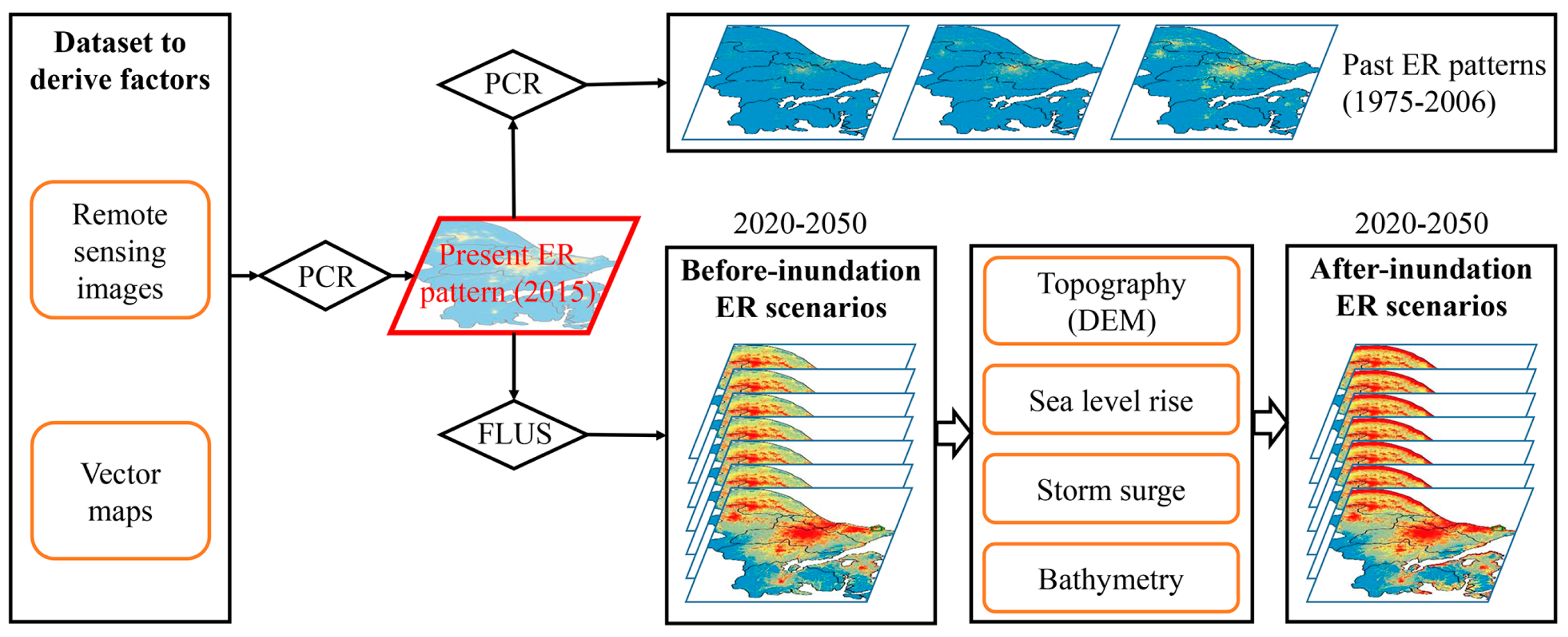
Figure ii. Location and administrative boundaries of Ningbo Metropolis: (a) false-color Landsat blended prototype for 2006; and (b) a 2010 map for terrain attribute reflected in 10 azimuthal categories.
Figure 2. Location and authoritative boundaries of Ningbo Metropolis: (a) simulated-color Landsat blended image for 2006; and (b) a 2010 map for terrain aspect reflected in x azimuthal categories.
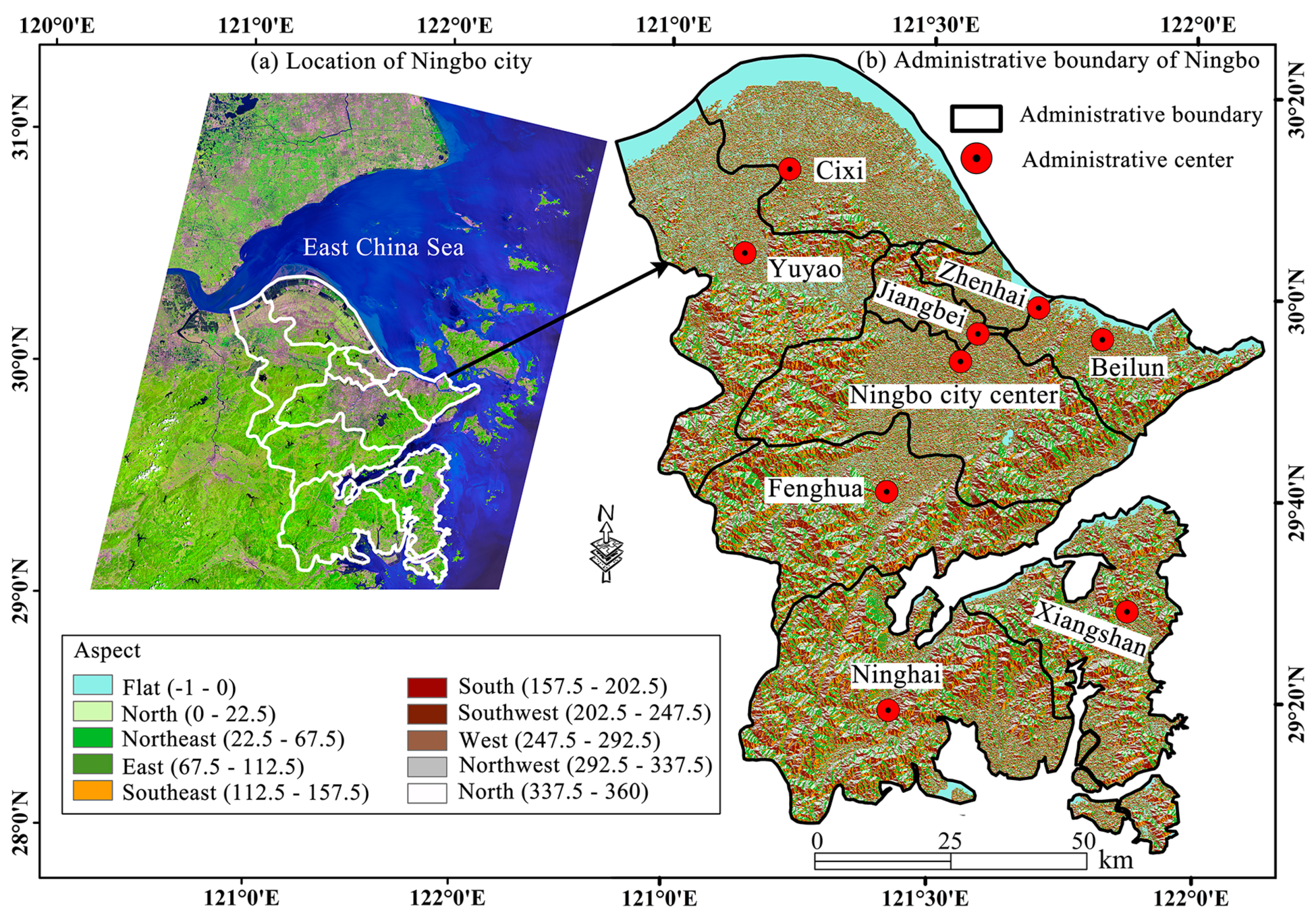
Figure three. Maps of proximity factors, normalized deviation vegetation index (NDVI) and normalized divergence built-up index (NDBI) from 1975 to 2015 [21].
Figure 3. Maps of proximity factors, normalized difference vegetation alphabetize (NDVI) and normalized difference built-up index (NDBI) from 1975 to 2015 [21].
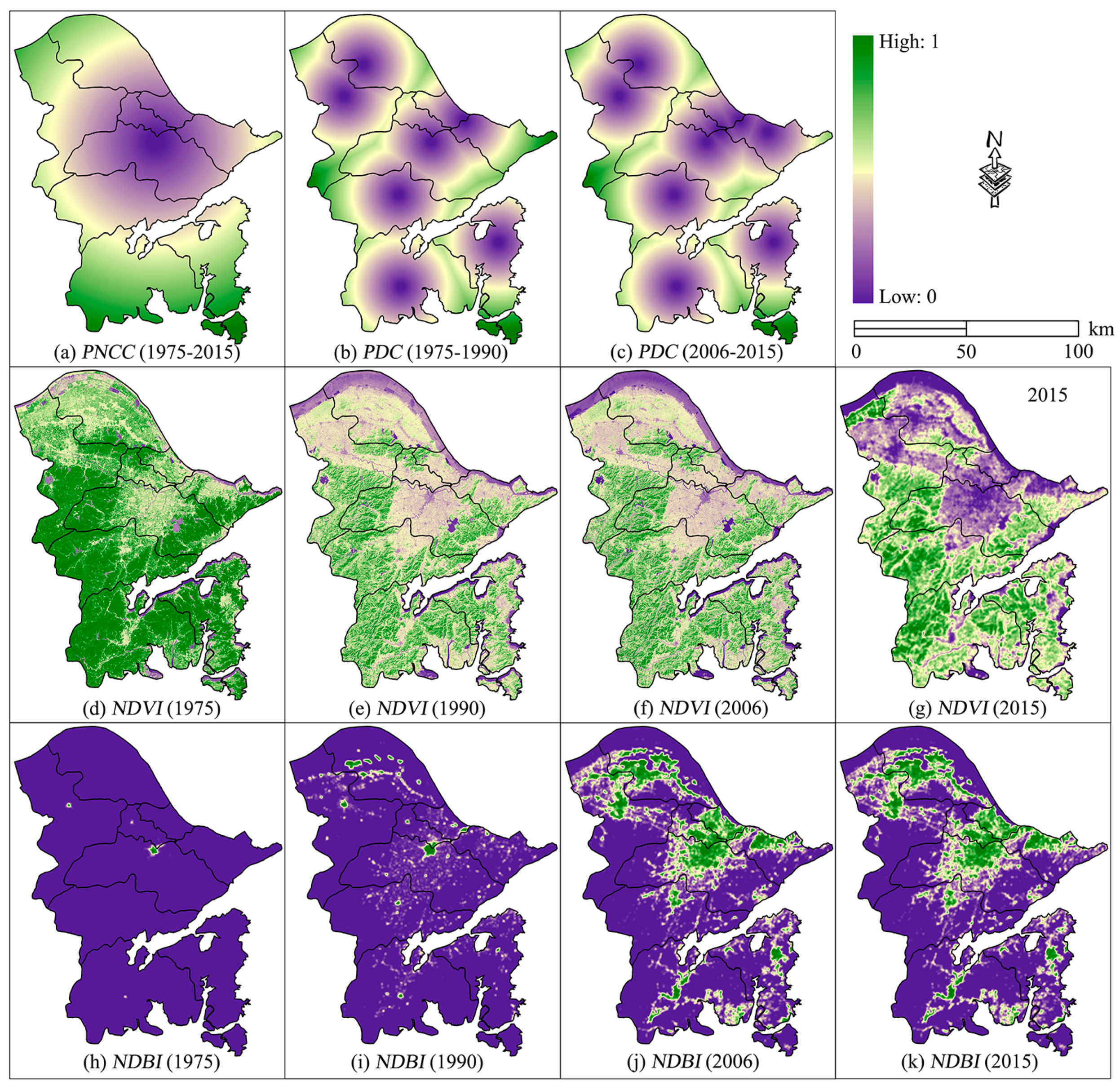
Figure 4. RER patterns at Ningbo for 1975 (a), 1990 (b), 2006 (c) and 2015 (d).
Effigy 4. RER patterns at Ningbo for 1975 (a), 1990 (b), 2006 (c) and 2015 (d).
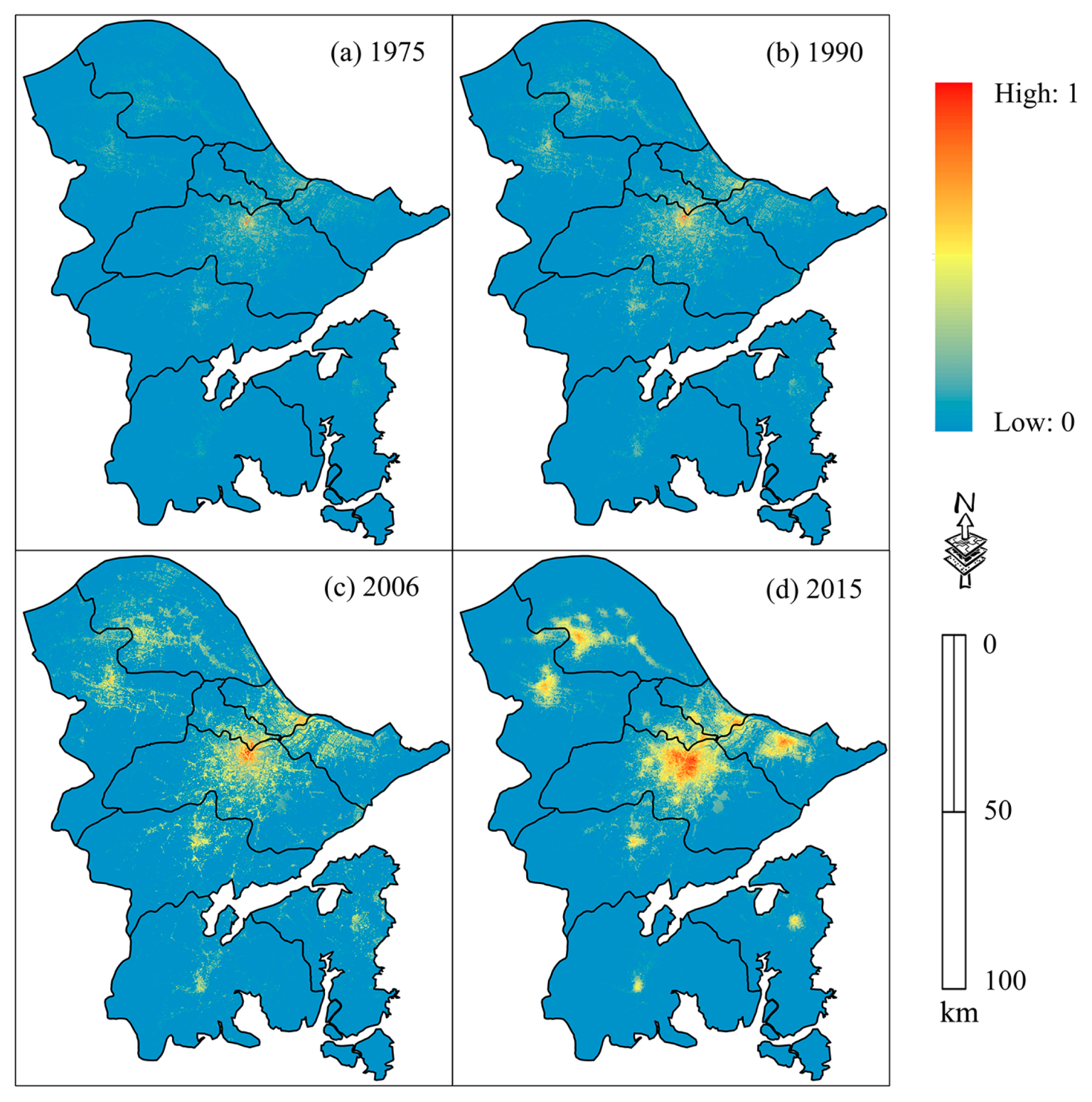
Effigy five. Frequency distribution of 1975 (a), 1990 (b), 2006 (c) and 2015 (d) RER scores, and the blackness curve is the all-time-fitted distribution.
Figure 5. Frequency distribution of 1975 (a), 1990 (b), 2006 (c) and 2015 (d) RER scores, and the black curve is the best-fitted distribution.
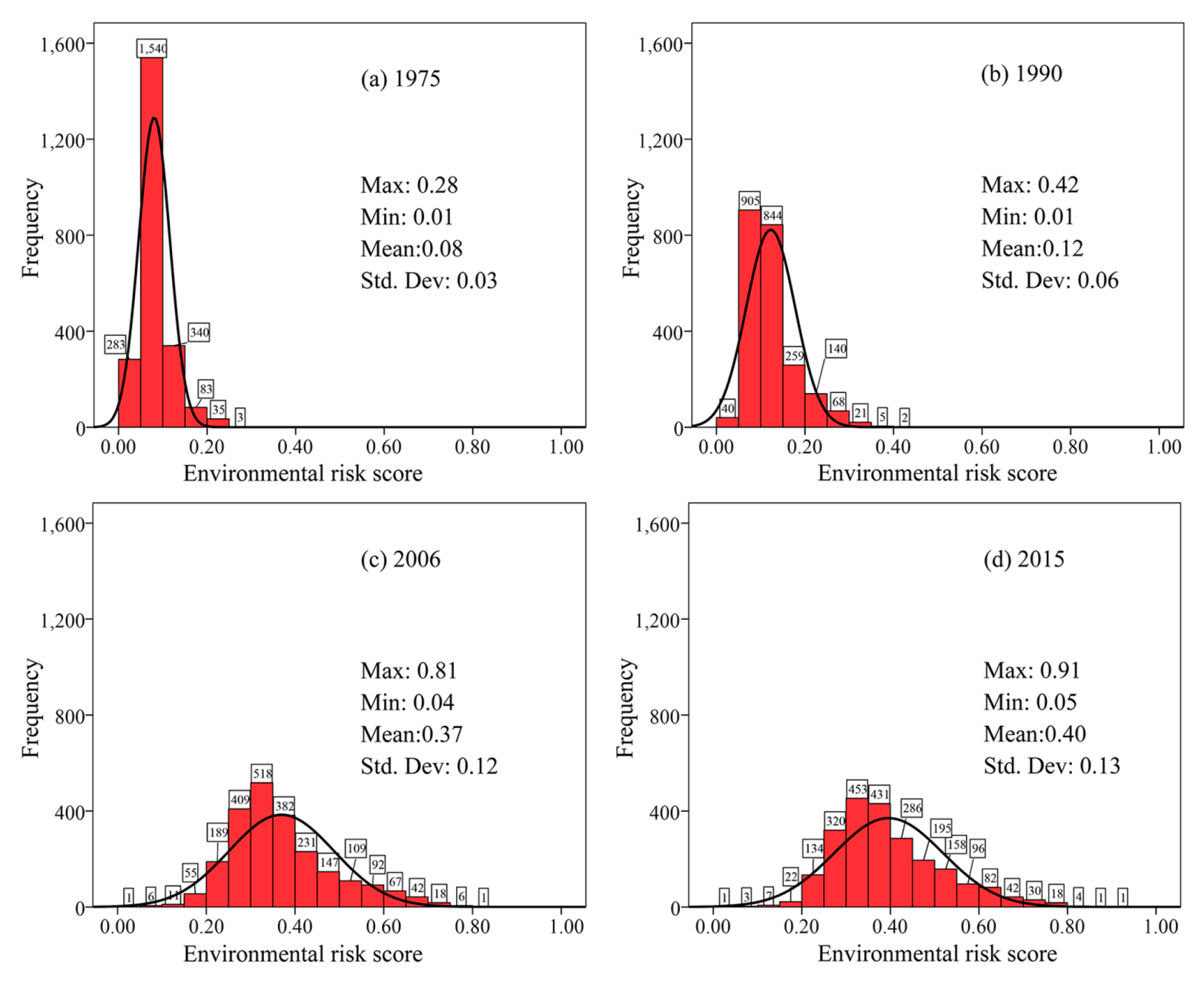
Effigy 6. RER modify at Ningbo: ruddy denotes increased gamble, yellow denotes persistent (steady) run a risk, green denotes decreased risk.
Effigy 6. RER modify at Ningbo: red denotes increased hazard, yellow denotes persistent (steady) risk, green denotes decreased risk.
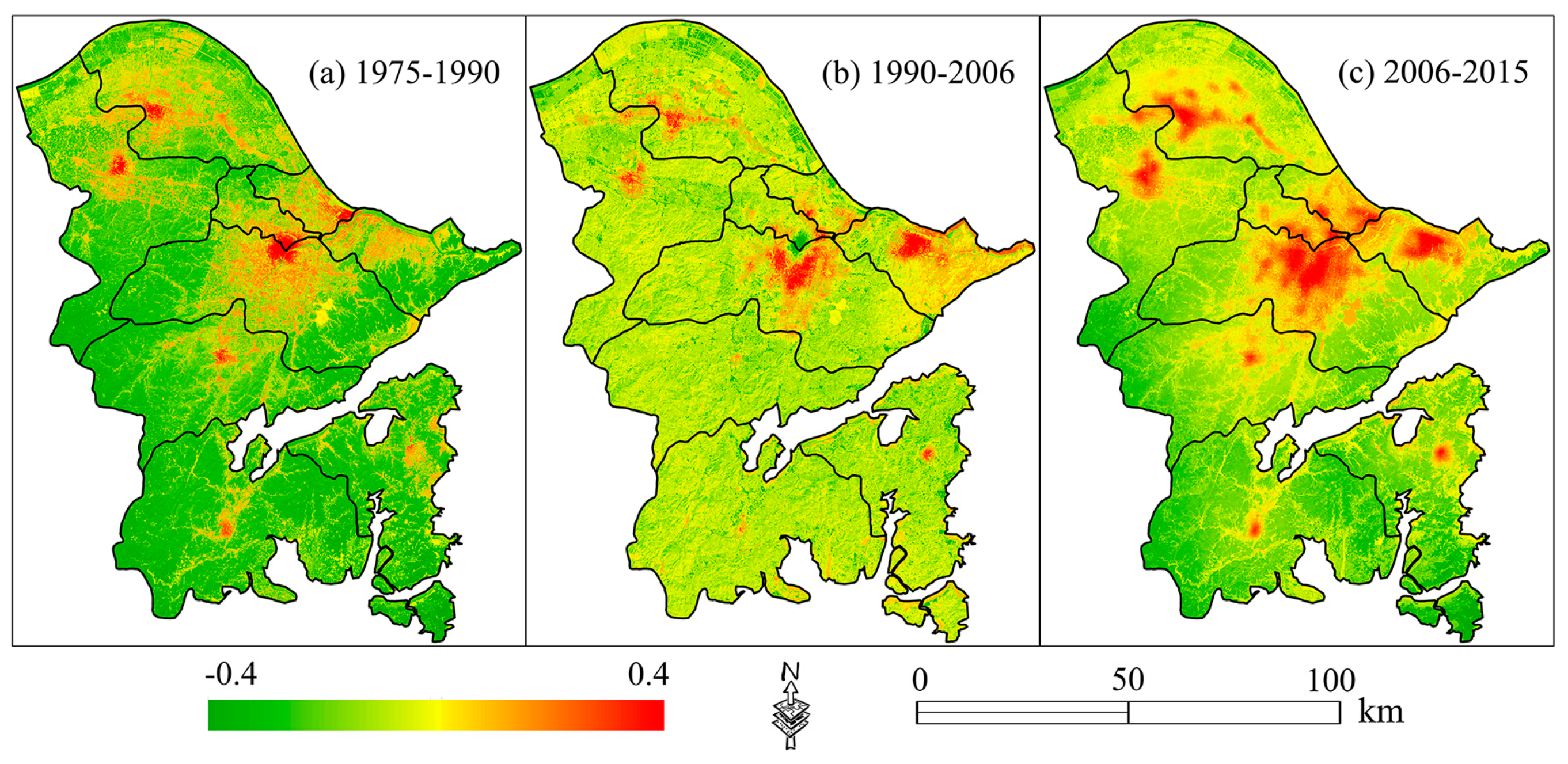
Figure seven. Assessment and simulation of 2015 five-level-based RER patterns.
Figure 7. Assessment and simulation of 2015 five-level-based RER patterns.
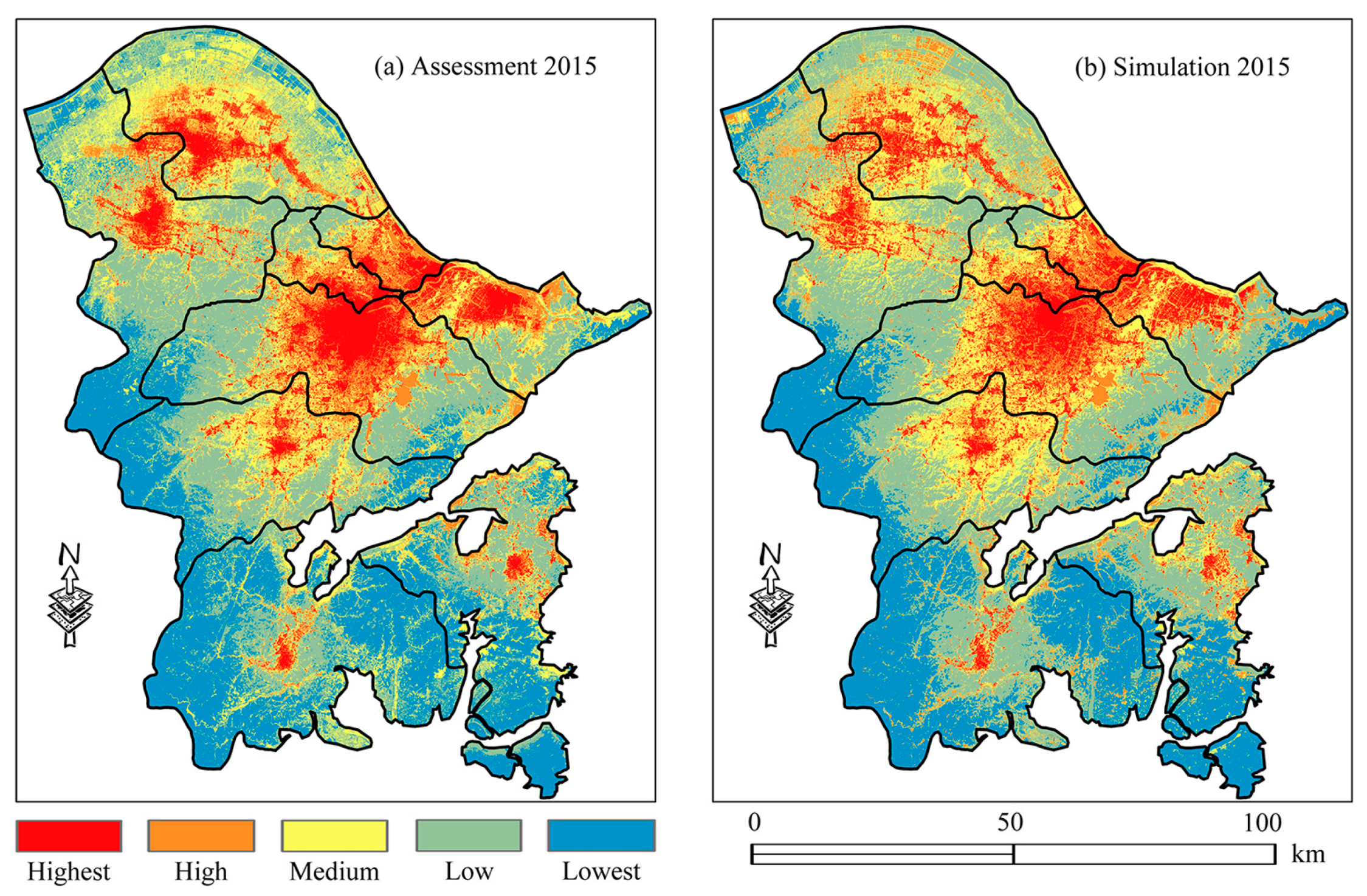
Figure 8. RER futurity projections at Ningbo from 2020 to 2050.
Figure 8. RER future projections at Ningbo from 2020 to 2050.
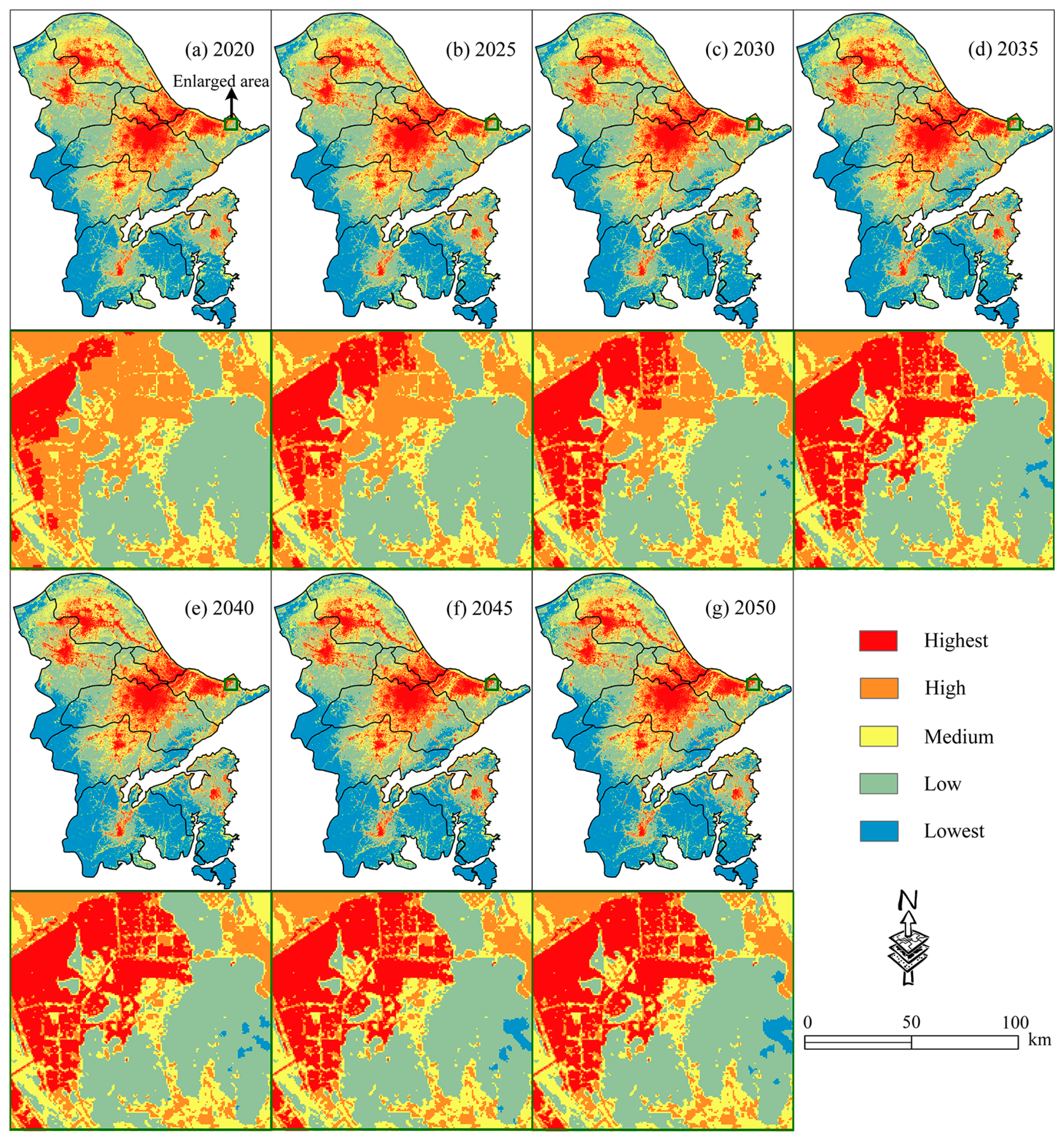
Effigy 9. Storm-surge-caused RER in the 10 m inundation case: (a) flooding hours; (b) RER related to inundation.
Figure 9. Storm-surge-caused RER in the 10 m inundation example: (a) flooding hours; (b) RER related to inundation.
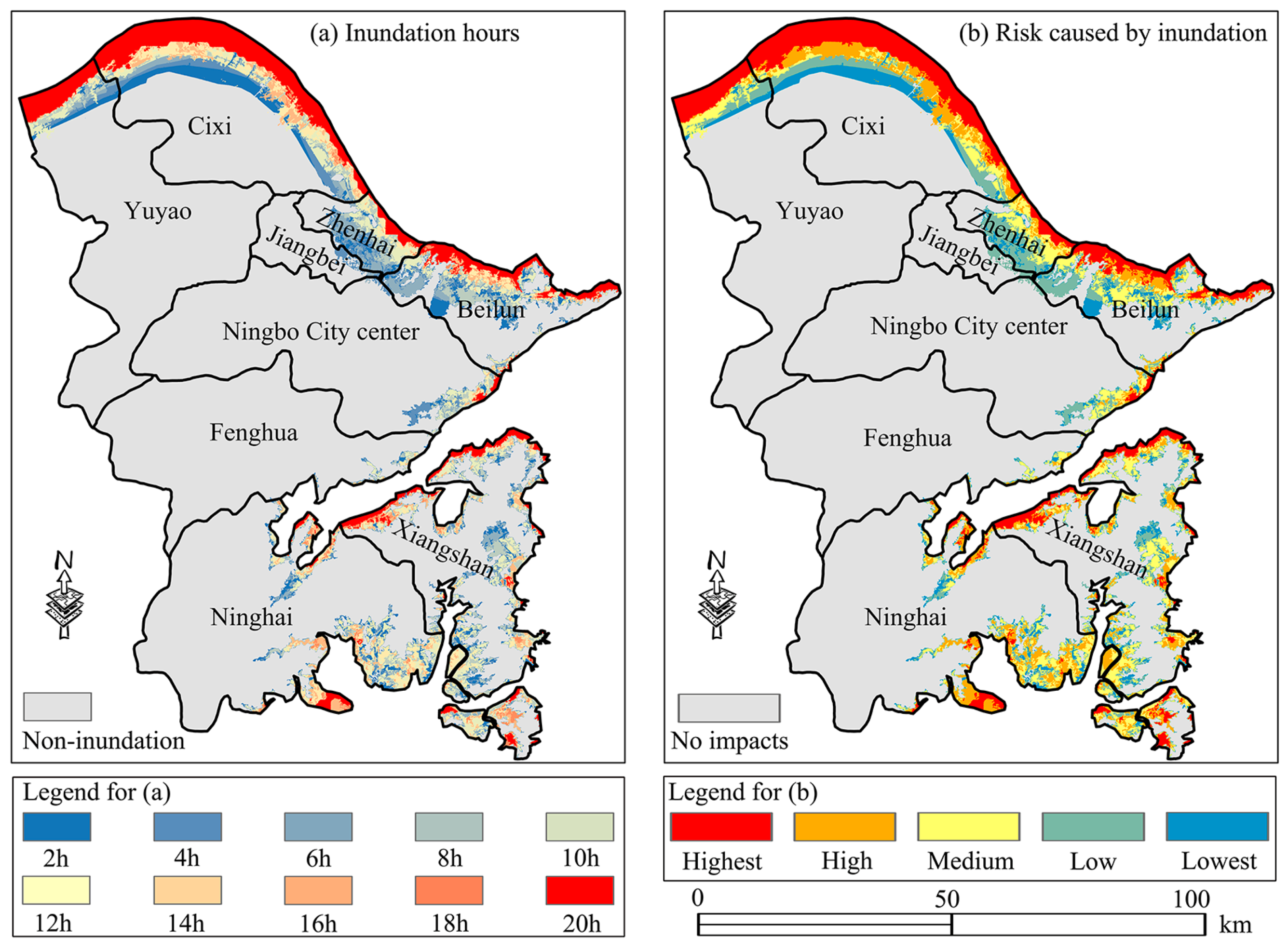
Figure 10. Future RER scenarios at Ningbo from 2020 to 2050 that include the influence of 10 m storm-surge inundation.
Figure 10. Future RER scenarios at Ningbo from 2020 to 2050 that include the influence of 10 k storm-surge inundation.
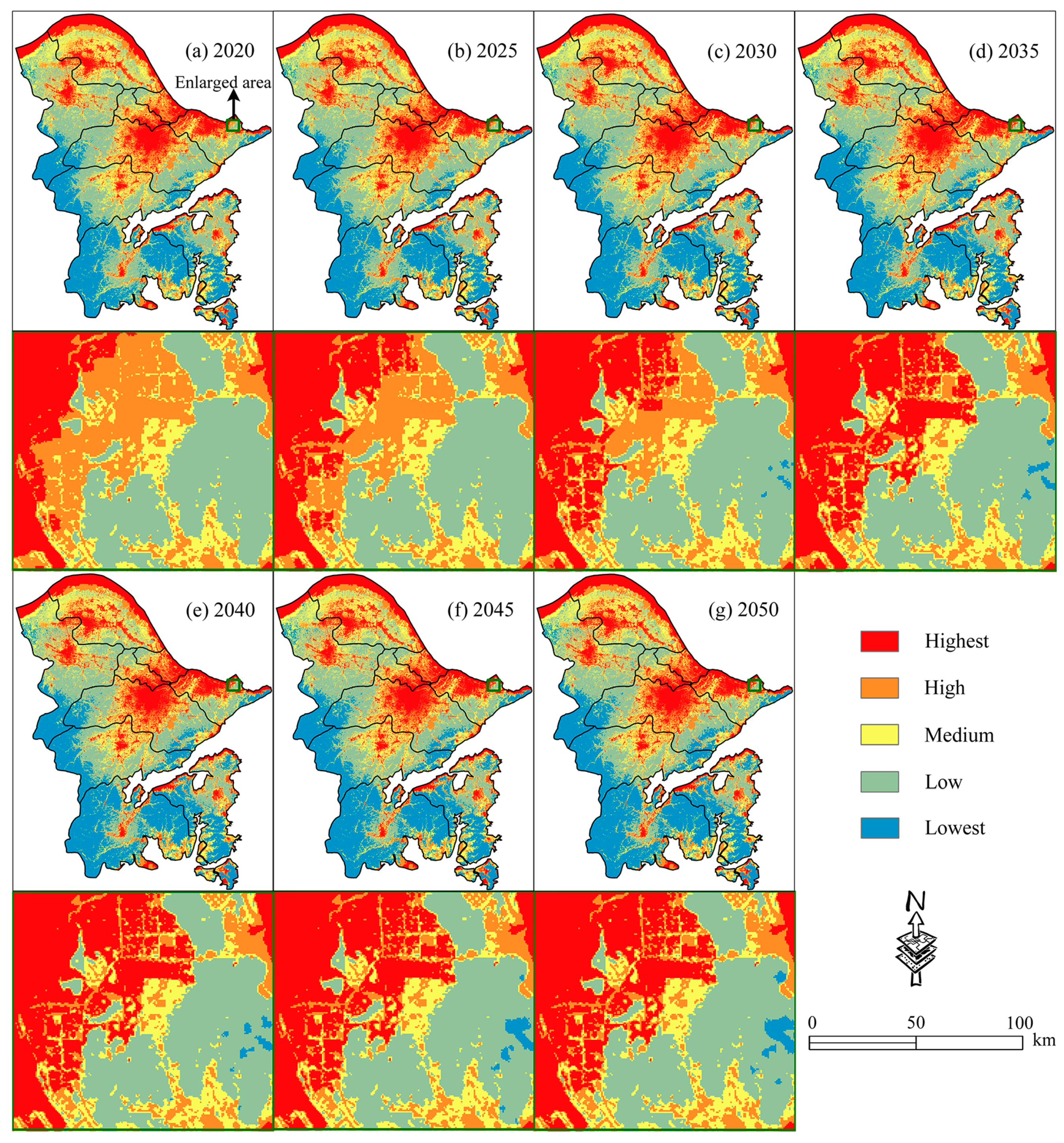
Table 1. Spatial data and satellite imagery used in this study.
Table 1. Spatial data and satellite imagery used in this study.
| Raw Information | Type | Date | Description | Provider |
|---|---|---|---|---|
| Administrative maps | Graphic | 1990, 2006 | Administrative boundaries and centers | National Catalogue Service for Geographic Data (www.webmap.cn) |
| Landsat-1 (MSS) | Image | 1975.2 | A remote sensing paradigm for assessing vegetation coverage and built-up area | Open Spatial Data Sharing Project (ids.ceode.air-conditioning.cn) |
| Landsat-5 (TM) | Image | 1990.6 | A remote sensing epitome for assessing vegetation coverage and congenital-up area | Open Spatial Data Sharing Projection (ids.ceode.ac.cn) |
| Landsat-5 (TM) | Image | 2006.3 | A remote sensing image for assessing vegetation coverage and built-up surface area | Open Spatial Information Sharing Project (ids.ceode.ac.cn) |
| Landsat-8 (OLI) | Prototype | 2015.one | A remote sensing prototype for assessing vegetation coverage and congenital-upwards area | Open up Spatial Data Sharing Project (ids.ceode.air-conditioning.cn) |
| ASTER GDEM | Prototype | 2010.seven | A map of Ningbo terrain | Geospatial Data Cloud (gscloud.cn) |
Table ii. Selected spatial influencing factors for assessing regional environmental risk (RER) patterns in Ningbo.
Table 2. Selected spatial influencing factors for assessing regional ecology take a chance (RER) patterns in Ningbo.
| Variable | Significant | Purpose |
|---|---|---|
| PNCC | Proximity to Ningbo City center | Produce the distance to the Ningbo City center and evaluate its impact on the environments. |
| PDC | Proximity to district centers | Produce the distances to the district centers and evaluate their impact on the environments. |
| NDBI | Normalized divergence congenital-up index | Produce the built-upward density and evaluate its impact on the environments. |
| NDVI | Normalized difference vegetation index | Produce the vegetation coverage and evaluate its bear upon on the environments. |
Table 3. A summary of the indicators of the RER cess and projection methods.
Table 3. A summary of the indicators of the RER assessment and project methods.
| Item | Method | Indicator |
|---|---|---|
| Definition of five-level RER | Score classification | Everyman risk [0.0, 0.2), low risk [0.two, 0.4), medium adventure [0.iv, 0.six), high risk [0.vi, 0.eight), and highest risk [0.eight, 1.0] |
| RER assessment method | Principal component analysis (PCA) | Full cumulative variance |
| RER project method | Cellular automata (FLUS) | Kappa, overall accuracy, producer's accuracy, user's accuracy, omission error, and commission error |
Table four. Accuracy and error of future land utilize simulation (FLUS) simulation of 2015 RER.
Table four. Accurateness and fault of future state use simulation (FLUS) simulation of 2015 RER.
| ER Level | Overall Accuracy (%) | Kappa Coefficient (%) | Producer's Accuracy (%) | User'southward Accuracy (%) | Omission Error (%) | Commission Mistake (%) |
|---|---|---|---|---|---|---|
| Highest | 77.nine | 77.3 | 88.9 | 88.viii | 11.1 | 11.two |
| High | 69.4 | 64.six | thirty.half-dozen | 35.4 | ||
| Medium | 71.1 | 71.2 | 28.9 | 28.eight | ||
| Low | 81.three | 81.iii | eighteen.7 | 18.7 | ||
| Lowest | 85.3 | 88.3 | fourteen.7 | 11.7 |
Table 5. Percentage area for each RER level through time.
Tabular array v. Percent area for each RER level through fourth dimension.
| Yr | Pct at Each RER Level | ||||
|---|---|---|---|---|---|
| Highest | High | Medium | Low | Lowest | |
| 2015 | 9.i | ten.eight | 21.six | 35.five | 23.one |
| 2020 | 10.0 | x.1 | 21.0 | 34.iv | 24.5 |
| 2025 | 11.0 | nine.5 | 20.iv | 33.3 | 25.8 |
| 2030 | 12.0 | 8.nine | nineteen.7 | 32.2 | 27.2 |
| 2035 | 13.0 | viii.3 | xix.ane | 31.0 | 28.half dozen |
| 2040 | 13.nine | seven.7 | 18.5 | 30.0 | 29.9 |
| 2045 | fourteen.ix | 7.one | 17.8 | 28.nine | 31.three |
| 2050 | 15.ix | 6.5 | 17.1 | 27.nine | 32.half-dozen |
Tabular array 6. Flooding hour and area related to each alluvion depth interval.
Table six. Flooding hour and area related to each inundation depth interval.
| Flooding Hour | Flooding Area (km2) Corresponding to Different Bathymetry | |||||||||
|---|---|---|---|---|---|---|---|---|---|---|
| i grand | 2 g | three k | four 1000 | 5 m | 6 m | 7 g | 8 m | 9 m | 10 thousand | |
| 2 | 503.six | 61.2 | 172.7 | 218.9 | 275.three | 231.2 | 217.8 | 192.ane | 100.0 | 132.0 |
| 4 | 0 | 503.half dozen | 61.2 | 172.7 | 218.9 | 275.3 | 231.2 | 217.8 | 192.1 | 100.0 |
| 6 | 0 | 0 | 503.6 | 61.2 | 172.7 | 218.9 | 275.3 | 231.two | 217.8 | 192.1 |
| viii | 0 | 0 | 0 | 503.6 | 61.2 | 172.vii | 218.9 | 275.3 | 231.two | 217.8 |
| 10 | 0 | 0 | 0 | 0 | 503.6 | 61.2 | 172.7 | 218.9 | 275.3 | 231.two |
| 12 | 0 | 0 | 0 | 0 | 0 | 503.6 | 61.2 | 172.7 | 218.9 | 275.3 |
| 14 | 0 | 0 | 0 | 0 | 0 | 0 | 503.6 | 61.2 | 172.7 | 218.9 |
| 16 | 0 | 0 | 0 | 0 | 0 | 0 | 0 | 503.6 | 61.two | 172.7 |
| 18 | 0 | 0 | 0 | 0 | 0 | 0 | 0 | 0 | 503.6 | 61.2 |
| 20 | 0 | 0 | 0 | 0 | 0 | 0 | 0 | 0 | 0 | 503.6 |
| Total | 503.half-dozen | 564.8 | 737.5 | 956.4 | 1231.7 | 1462.nine | 1680.7 | 1872.eight | 1972.eight | 2104.viii |
Table 7. RER levels and their area considering the influence of tempest surges.
Table vii. RER levels and their expanse considering the influence of tempest surges.
| No Touch on (km2) | Affected Surface area (km2) | Total Area (km2) | ||||
|---|---|---|---|---|---|---|
| Highest | High | Medium | Low | Lowest | ||
| 7064.viii | 564.8 | 391.6 | 506.v | 409.8 | 231.ix | 9169.four |
Tabular array 8. Percentage surface area at each RER level because the influence of tempest surge.
Tabular array 8. Percentage area at each RER level considering the influence of storm surge.
| Year | Percent (%) | ||||
|---|---|---|---|---|---|
| Highest | High | Medium | Depression | Lowest | |
| 2020 | xv.half-dozen | xiii.0 | 20.9 | 29.7 | xx.eight |
| 2025 | 16.1 | 12.4 | 21.0 | 28.9 | 21.6 |
| 2030 | 16.7 | xi.9 | 20.ix | 28.1 | 22.four |
| 2035 | 17.4 | eleven.3 | xx.8 | 27.2 | 23.3 |
| 2040 | 17.6 | 11.0 | twenty.eight | 26.four | 24.2 |
| 2045 | 17.7 | 11.0 | xx.eight | 25.5 | 25.0 |
| 2050 | 17.seven | 11.0 | 20.seven | 24.7 | 25.9 |
© 2019 past the authors. Licensee MDPI, Basel, Switzerland. This article is an open access article distributed under the terms and conditions of the Artistic Commons Attribution (CC Past) license (http://creativecommons.org/licenses/by/iv.0/).
wooldridgethavetind1974.blogspot.com
Source: https://www.mdpi.com/2071-1050/11/6/1560/htm
0 Response to "Terri Albanese Mosaic Art an International Portfolio of Contemporary Mosaic Art"
Post a Comment